ABS AUDI RS7 SPORTBACK 2015 Owners Manual
[x] Cancel search | Manufacturer: AUDI, Model Year: 2015, Model line: RS7 SPORTBACK, Model: AUDI RS7 SPORTBACK 2015Pages: 302, PDF Size: 74.76 MB
Page 14 of 302
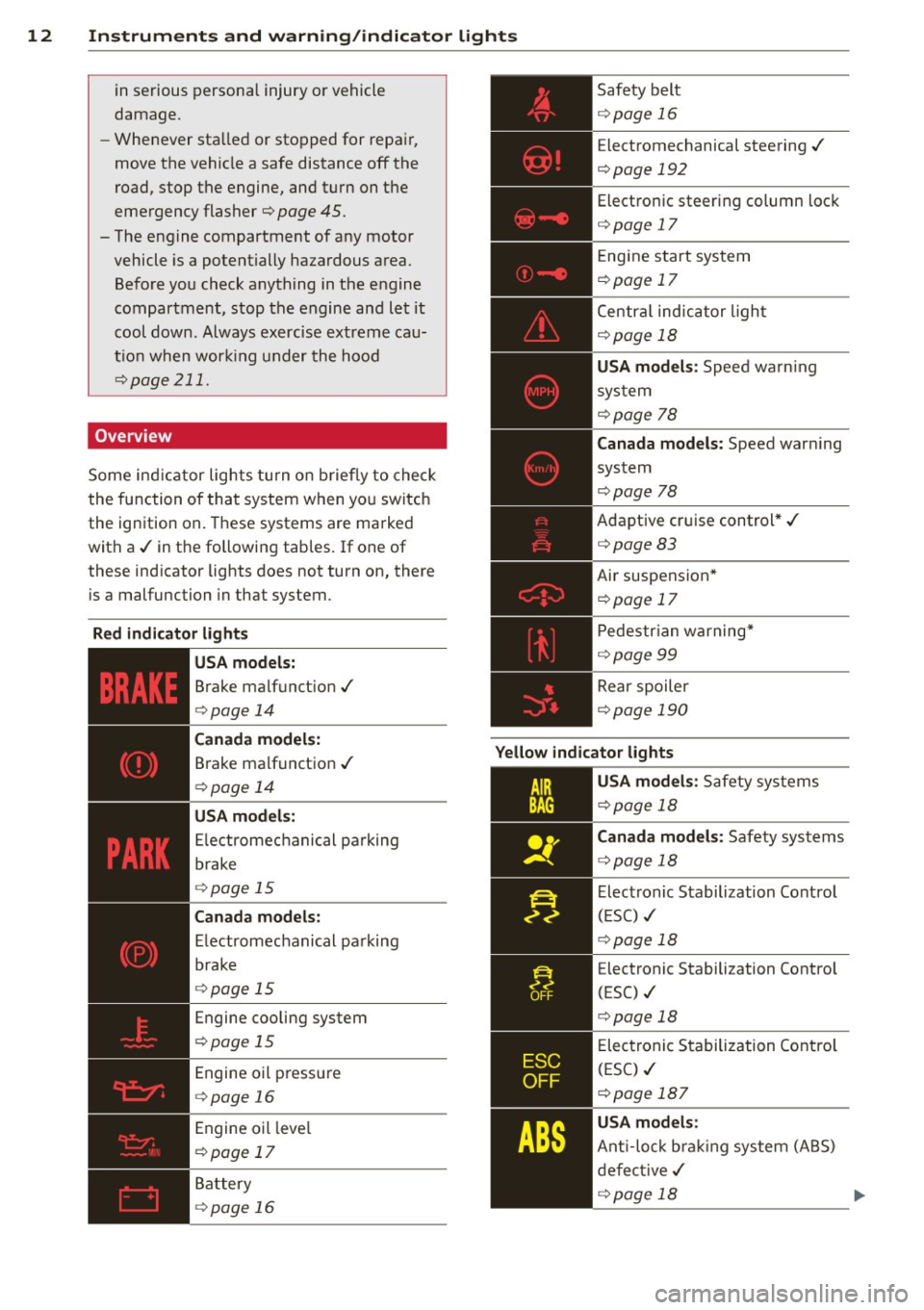
12 Instrum ent s and w arn ing /indic ato r light s
in serious persona l injury or vehicle
damage.
- Whenever sta lled or stopped for repair,
move the vehicle a safe distance off the
road, stop the engine, and turn on the
emergency flasher
¢ page 45.
- The engine compartment of any motor vehicle is a potentially hazardous area.
Before you check anything in the engine
compartment, stop the engine and let it
cool down. Always exercise extreme cau
t ion when wor king under the hood
¢page 211.
Overview
Some ind icator lights tu rn o n briefly to check
the function of that system when yo u switch
the ignition on. These systems are marked
with a ./ in the fo llowing tab les. If one of
these ind icator lights does not turn on, there
is a malfunction in that system .
Red ind icator light s
-------------
USA mo del s:
Brake malfunct ion ./
¢page 14
Safety belt
¢page 16
Electromechanical steering ./
¢page 192
Electronic steering column lock
¢page 17
Engine start system
¢page 17
Centra l indicator light
¢ page 18
USA model s: Speed warning
sys tem
¢ page 78
Canada models : Speed warning
system
¢ page 78
Adaptive cruise control *./
¢page83
Air suspension *
¢page 17
Pedestr ian warning*
~ page 99
Rear spoiler
¢page 190
Canad a mod els :
Brake malfunction ./
¢page 14
Yello w ind ic a to r lights
U SA mo dels:
El ectromechanical pa rking
brake
¢ page 15
Canada model s:
Electromechanical parking
brake
¢ page 15
Engine cooling system
¢page 15
Engine oil pressure
¢page 16
Engine oil leve l
¢page 17
Battery
¢page 16
-------------
USA m odels: Safety sy stems
¢ page 18
Canada mod els: Safety systems
¢ page 18
Electronic Stabilization Control
(ESC) ./
¢page 18
Electronic Stabilization Control
(ESC) ./
¢page 18
Electronic Stabilization Cont ro l
(ESC) ./
¢page 187
USA m odel s:
Ant i- lock bra king system (ABS)
de fect ive ./
¢page 18 ..,.
Page 15 of 302
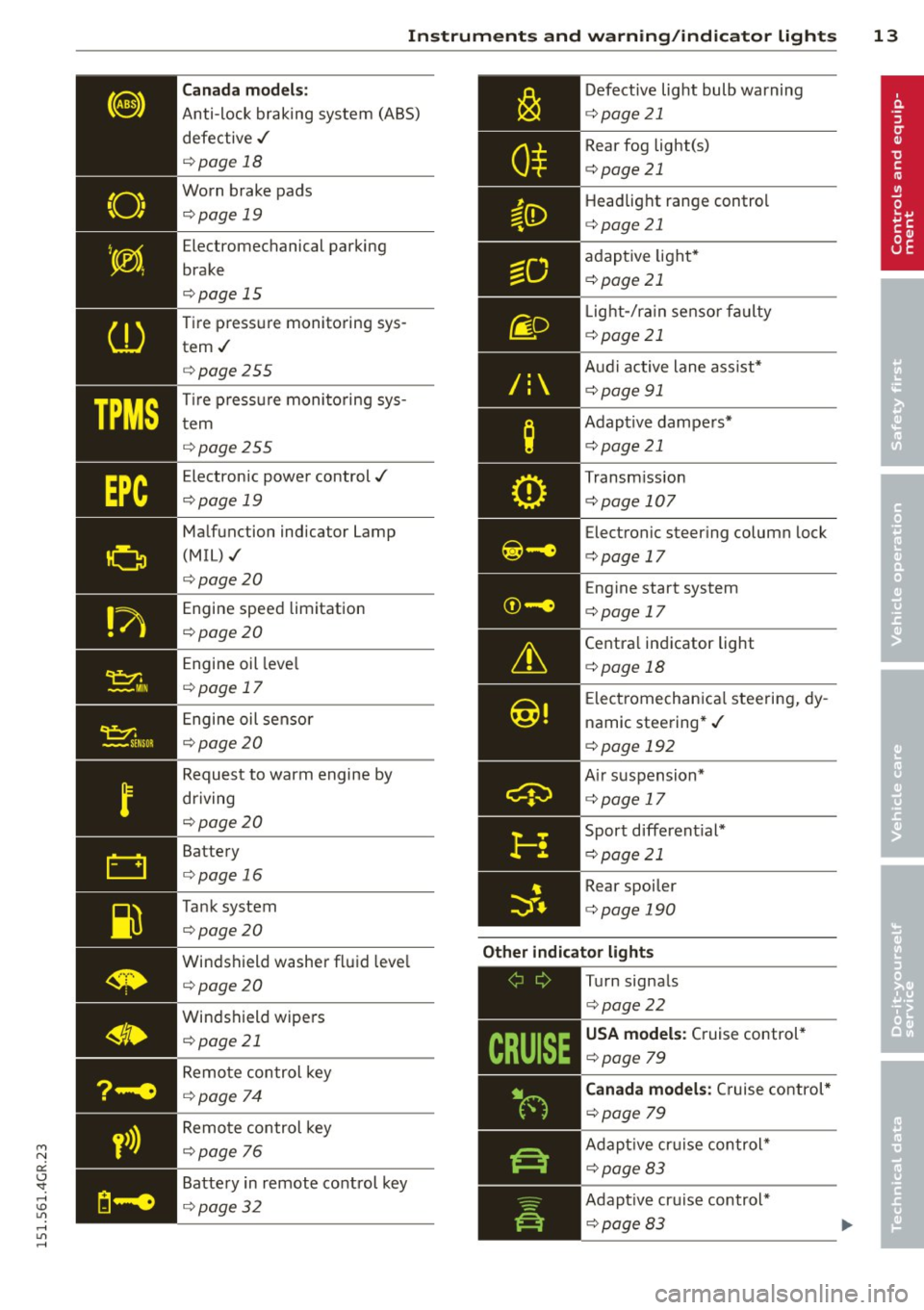
M N
0:: <.J 'SI: ,...., \!) 1.1'1 ,...., 1.1'1 ,....,
Instrument s and warnin g/indic ator ligh ts 13
Canada m odel s:
Anti-lock braking system (ABS)
defective ,/
¢ page 18
Worn brake pads ¢page 19
Electromechanical parking
brake
¢ page 15
Tire pressure monitoring sys tem./
¢ page 255
Tir e p ress ure monitoring sys
tem
¢ page 255
Electronic power control./
¢ page 19
Malfunction indicator Lamp
(MIL),/
¢page 20
Engine speed limitation
¢ page 20
Engine oil leve l
¢ page 17
Engine oil sensor
¢ page 20
Request to warm engine by
driving
¢ page 20
Battery
¢ page 16
Tank system
¢page 20
Windshield washer fluid leve l
¢ page 20
Windshield wipers ¢ page 21
Remote control key
¢ page 74
Remote control key
¢ page 76
Battery in remote control key
¢ page 32
/:
Defective light bulb warning
c:::> page 21
Rear fog light(s)
c:::> page 21
Headlight range control
c:::> page 21
adaptive light*
c:::> page 21
L ight-/ra in sensor fa ulty
c:::>page 21
Aud i active lane ass ist*
c:::> page 91
Adapt ive dampers*
c:::>page 21
Transm iss ion
c:::> page 107
Electronic steering column lock
c:::> page 17
Eng ine start system
c:::>page 17
Centra l ind icator light
c:::> page 18
E lectromechanica l steering, dy
namic steering* ,/
c:::> page 192
A ir suspension*
c:::> page 17
Sport d ifferent ial*
c:::> page 21
Rear spoiler
c:::> page 190
Other indicator light s
-------------
Turn signals
c:::> page22
USA model s: Cruise control *
c:::> page 79
Canada models: C ruise control*
c:::> page 79
Adapt ive cr uise control*
c:::> page 83
Adapt ive cr uise control*
c:::> page 83
Page 16 of 302
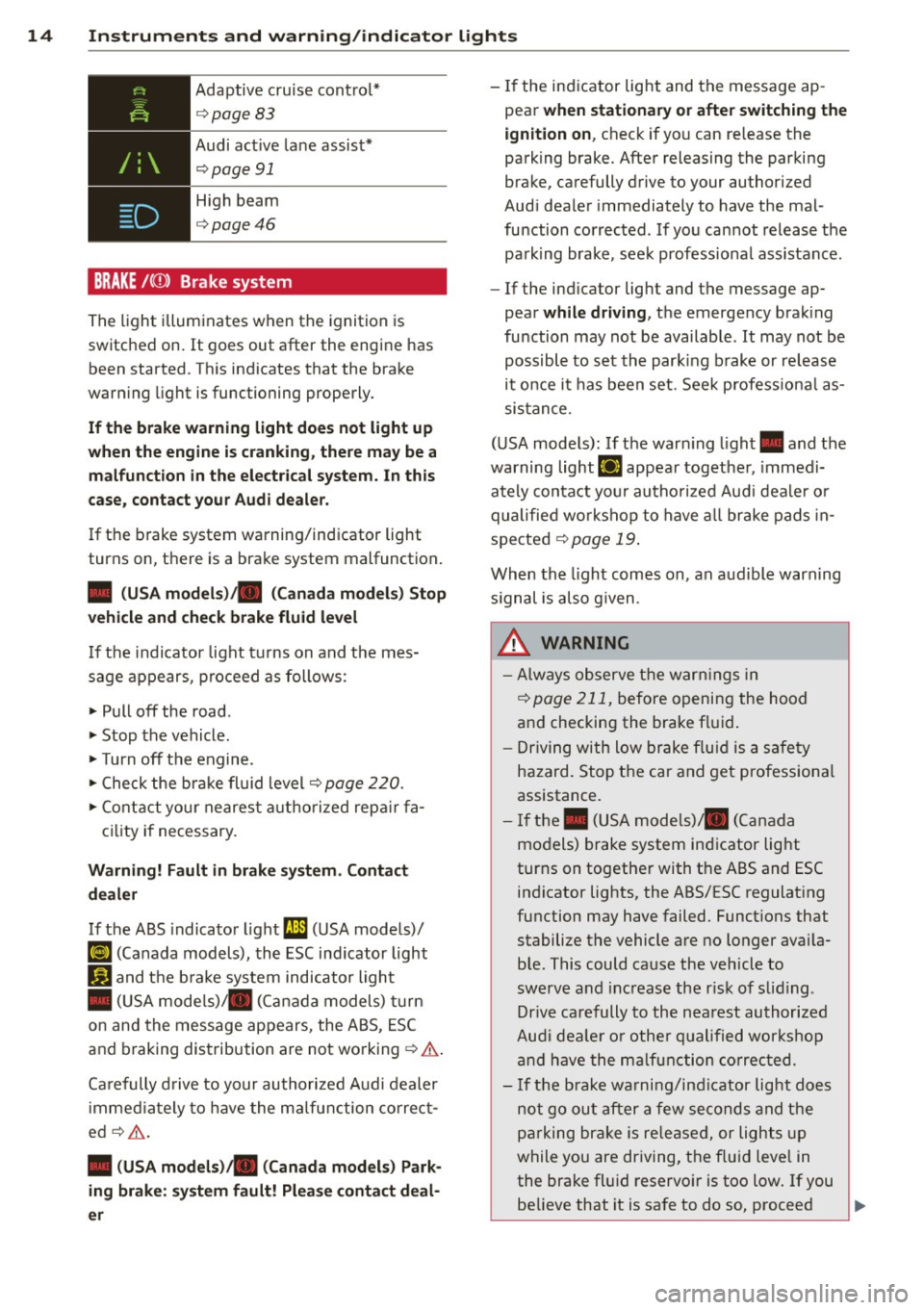
14 Instruments and warning/indicator lights
Adaptive cruise control*
9page 83
Audi act ive lane assist*
~ page 91
High beam
Qpage46
BRAKE/( ©) Brake system
The light illuminates when the ignition is
switched on. It goes out after the engine has
been started . Th is indicates that the brake
warn ing light is functioning properly.
If the brake warning light does not light up
when the engine is cranking , there may be a
malfunction in the electrical system. In this
case, contact your Audi dealer.
If the brake system warning/indicator light
turns on, there is a brake system malfunction .
• (USA models) ta (Canada models) Stop
vehicle and check brake fluid level
If the indicator light turns on and the mes
sage appears, proceed as follows :
"" Pull off the road .
.. Stop the vehicle.
""Turn off the engine .
""C heck the brake fluid level ¢
page 220.
""Contact your neares t authorized repair fa-
cility if necessary.
Warning! Fault in brake system. Contact
dealer
If the ABS indicator light rJlm (USA models)/
[iJ (Canada models), the ESC indicator light
G1 and the b rake system indicator light
• (USA models)/. (Canada models) turn
on and the message appears, the ABS, ESC
and braking distribution are not working ¢
A.
Ca refully drive to your authorized Aud i dealer
immediately to have the malfunction correct
ed ¢
,A.
• (USA models)/ . (Canada models) Park
ing brake : system fault! Please contact deal
er
- If the indicator light and the message ap
pear
when stationary or after switching the
ignition on ,
check if you can re lease the
parking brake. After releasing the parking
brake, carefully drive to your authorized
Aud i dea ler immediately to have the mal
fu nction corrected. If you cannot release the
park ing brake, seek professiona l assistance.
- If the ind icator light and the message ap
pear
while driving , the emergency brak ing
function may not be available . It may not be
possible to set the park ing brake or release
it once it has been set. Seek profess iona l as
sis tance.
(USA models) : If the warn ing light. and the
warning light
E+J appear together, immedi
ately contact your au tho rized Aud i dealer or
qualified wo rkshop to have all brake pads in
spected
¢ page 19 .
When the light comes on, an aud ible warning
s ignal is also g iven .
_& WARNING
-Always observe the warnings in
¢
page 211, before opening the hood
and checking the brake fluid .
- Driving with low brake fluid is a safety
hazard. Stop the car and get professiona l
assistance.
- If the. (USA models)/ . (Canada
models) brake system indicator light
turns on togethe r with the ABS and ESC
indicator lights, the ABS/ESC regulating
function may have failed. Functions that
stabilize the vehicle are no longer availa
ble. This could cause the vehicle to
swerve and increase the r isk of slid ing .
Drive carefully to the nearest authorized
Aud i dealer or other qualified workshop
and have the ma lfunction corrected.
- If the brake wa rning/ind icator light does
not go out after a few seconds and the pa rking brake is re leased, or lights up
while you are dr iving, the f lu id l eve l in
the brake fluid reservoir is too low. If you
believe that it is safe to do so, proceed
Iii>
Page 20 of 302
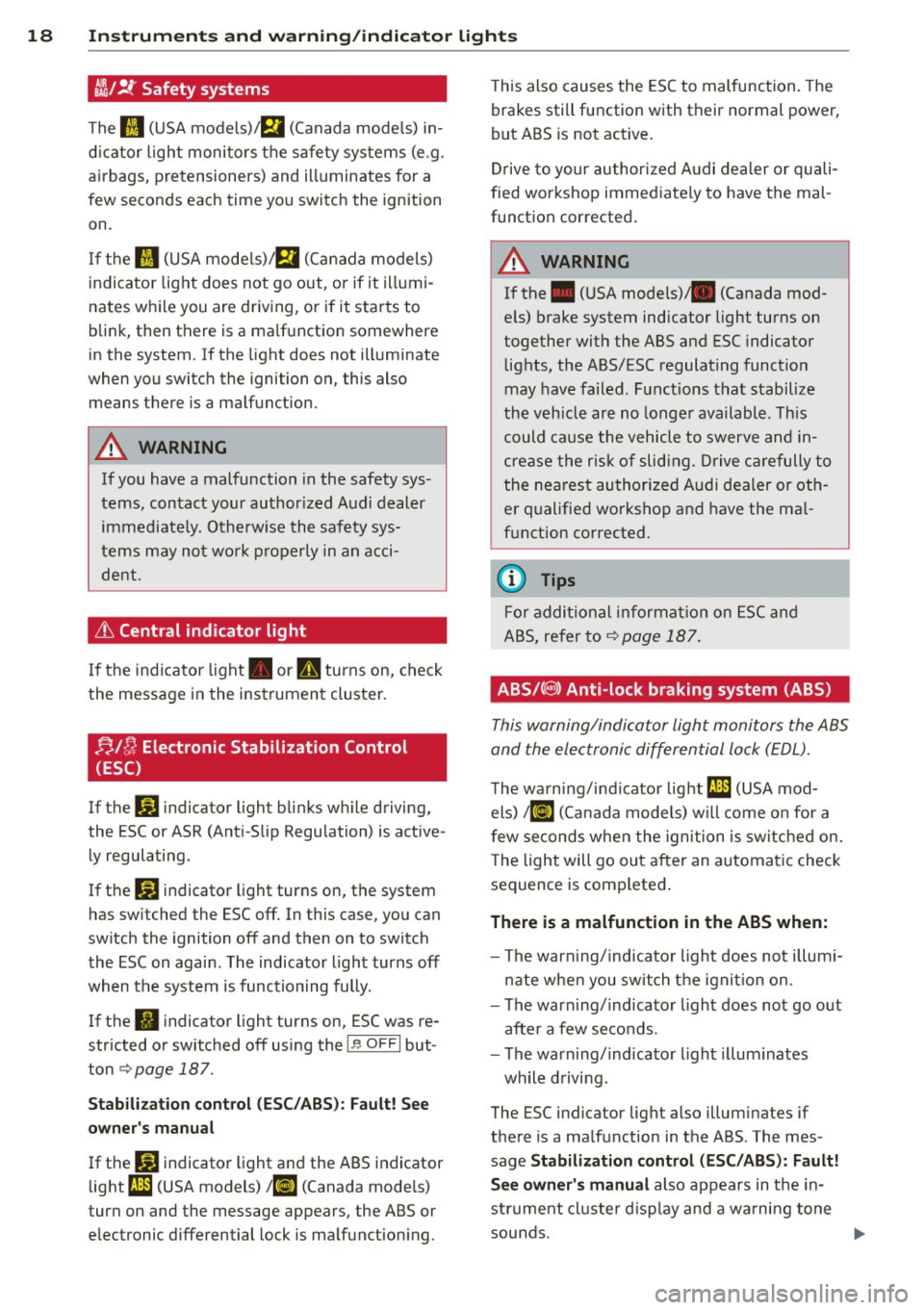
18 Instrum ent s and w arn ing /indic ato r light s
tl'l.l !f Safety systems
The II (USA models)/S,I (Canada mode ls) in
d icator light monitors the safety systems (e .g.
a irbags, pretensioners) and illuminates for a
few seconds each time you switch the ignition
on.
I f the
II (USA mode ls)/ S,I (Canada models)
indicator light does not go out, or if it illumi
nates while you are driving, or if it starts to
blink, then there is a ma lfunction somewhere
in the system.
If the light does not illuminate
when you switch the ignition on, this also means there is a malfunction.
A WARNING
If you have a malfunction in the safety sys
tems, contact your author ized Audi dealer
immediate ly. Otherwise the safety sys
tems may not wo rk properly in an acci
dent.
& Central indicator light
I f the indicator light . or II turns on, check
the message in the instrument cluster.
;;,J {J Electronic Stabilization Control
(ESC)
If the J,.J indicator light blinks wh ile driving,
the ESC or ASR (Ant i- S lip Regulation) is active
ly regulating .
If the
Ji! indicator light turns on, the system
has sw itched the ESC off. In this case, you can
switch the ignition off and then on to switch
the ESC on again . The indicator light turns off
when the system is functioning fully .
If the
fil indicator light turns on, ESC was re
stricted or switched off using the
I Y; OF F I but
ton
Q page 187 .
Stabilization cont rol (E SC/ABS): F ault! See
o w ner 's manual
If the Ji! indicator light and the ABS indicator
light
fi1 (USA models) I ii] (Canada models)
turn on and the message appears, the ABS or
e lec tronic differen tial lock is ma lfunction ing. T
his also causes the ESC to malfunction. The
brakes still function with their normal power,
but ABS is not active.
Drive to your au thorized A udi dealer or quali
fied workshop immed iate ly to have the mal
function corrected .
A WARNING
-If the . (USA mode ls)/ . (Canada mod-
e ls) b rake system indicator light turns on
together with the ABS and ESC indicator
lights, the ABS/ESC regulating function
may have failed . Fu nctions that stabilize
the veh icle are no longe r available . T his
could cause the vehicle to swerve and in
crease the risk of sliding. Drive carefully to
the nea rest au thori zed A udi dealer or oth
er qualified workshop and have the ma l
f u nction corrected.
@ Tips
Fo r additional in format ion on ESC and
ABS, refer to
Q page 187.
ABS/{ €,) Anti-lock braking system (ABS)
This warning/indicator light monitors the ABS
and the electronic differential lock (EDL).
The wa rning/indicator light fi1 (USA mod-
els)
/ KG!ff (Ca nada models) w ill come o n for a
f ew seconds when the ignition is sw itched on.
T he light will go out after an automatic check
sequence is comp leted .
There is a malfunction in the ABS when:
-The warning/indicato r light does not illum i
nate when you switch the ignit io n on.
- The warning/indicator l ight does not go out
after a few seconds.
- The warn ing/ indicator light illum inates
while d riving.
The ESC indicator lig ht also illum inates if
there is a malfunction in the ABS. The mes
sage
Stabi liz at ion control (ESC /ABS ): Fault!
See owner's manual
also appears in the in
st rument cluste r d isplay and a wa rning tone
sounds.
Page 21 of 302
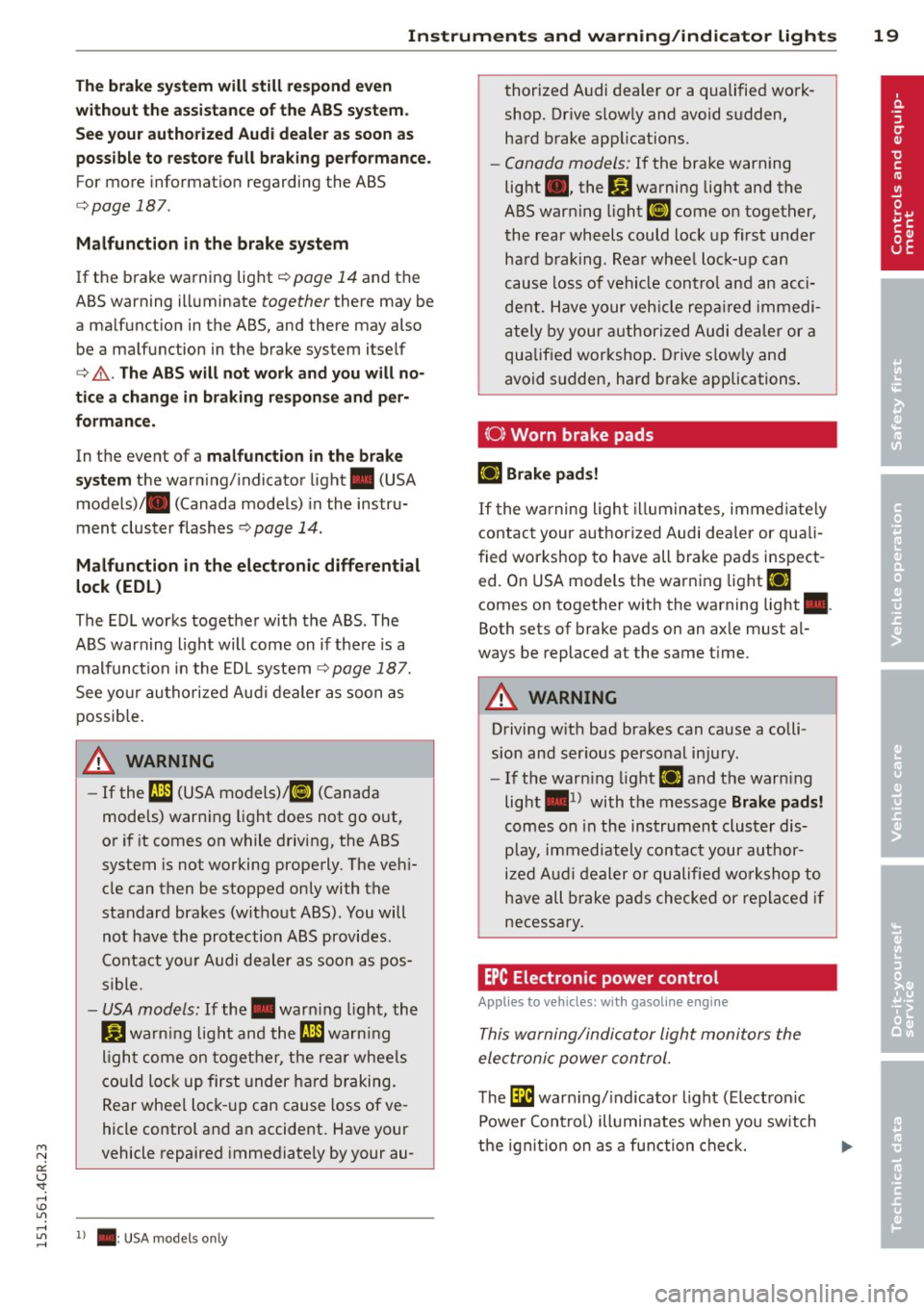
Instrument s and warnin g/indic ator ligh ts 19
M N
0:: <.J 'SI: ,...., \!) 1.1'1
The bra ke s ystem will still re sp ond e ven
w ithout th e ass is ta nce of the ABS system .
S e e you r a uthorized Audi dealer as soon as
po ssibl e to restore full brak ing p erformance.
For more informat ion regarding the ABS
c> page 187.
Malf uncti on in the brak e syste m
If the brake wa rning light c> pag e 14 and th e
ABS wa rning illuminate
together there may be
a ma lfunction in the ABS, and the re may also
be a mal func tion in the brake system it sel f
c> ,&. . Th e AB S will not work and you will no
tic e a ch ange i n braking re spon se and p er
formanc e.
In the event of a malfunct ion in the b ra ke
sy st e m
the warn ing/ indicator light . (USA
models)/ . (Canada models) in the instru
ment cluster flashes
c> page 14 .
Malfunction in the elect ronic differential
lock (EDL )
The ED L works together with the ABS. The
ABS warning light will come on if there is a
malfunct ion in the EDL system
c> page 187.
See yo ur au thorized Aud i dealer as soon as
possib le.
A WARNING
- If the fJl1 (USA models) ;t§J (Canada
models) warn ing light does not go out,
or if it comes on while driving, the ABS
system is not working properly . The veh i
cle can then be stopped only with the
standard brakes (without ABS). You will
not have the protection ABS provides .
Contact you r Audi dealer as soon as pos
sible.
- USA models: If the . warn ing light, the
Ji) warn ing light and the fJl1 warn ing
l igh t come on together , the re ar whee ls
cou ld lock up first under hard braking.
Rear wheel lock -up can cause loss of ve
hicle control and an accident. Have your
vehicle repaired immediately by your au-
5 1 > . : USA models only
thorized A udi dealer or a qualified work
shop. Drive s lowly and avoid s udden,
hard brake app lications.
- Canada models: If the brake warning
light ., the
Bl warning light and the
ABS warning light
EiJ come on together,
the rear wheels could lock up first under
hard b raking . Rea r whee l lock-up can
cause loss of vehicle contro l and an acci
dent. Have your veh icle repa ired immedi
ately by your authorized Audi de aler or a
qualif ied workshop . Drive s low ly and
avoid sudden, hard brake applications .
{0} Worn brake pads
llJ Brake pad s!
If the warning light illuminates, immed iate ly
contact your authorized Audi dea ler or quali
f ied workshop to have all brake pads inspect
e d. On USA mode ls the warning light
llJ
comes on together with the wa rning light •.
Bo th set s of brake pads on an axle mus t al
ways be replaced a t the s ame time .
A WARNING
Driving w ith bad brakes can cause a colli
sion and ser ious personal injury .
- If the warn ing light
llJ and the warn ing
light •
1
) with the message Brake pads!
comes on in the instrument cluster dis
play, immediately contact your author
i z ed Audi dealer or qualified wo rkshop to
have all brake pads checked or replaced if
necessary.
EPC Electronic power control
Applies to vehicles: with gasoline engine
This warning/indicator Light monitors the
electroni c power control.
The l3i warn ing/ indicator light (Electron ic
Power Control) illuminates when you sw itch
-
the ignit ion on as a function che ck. IJII>
Page 24 of 302
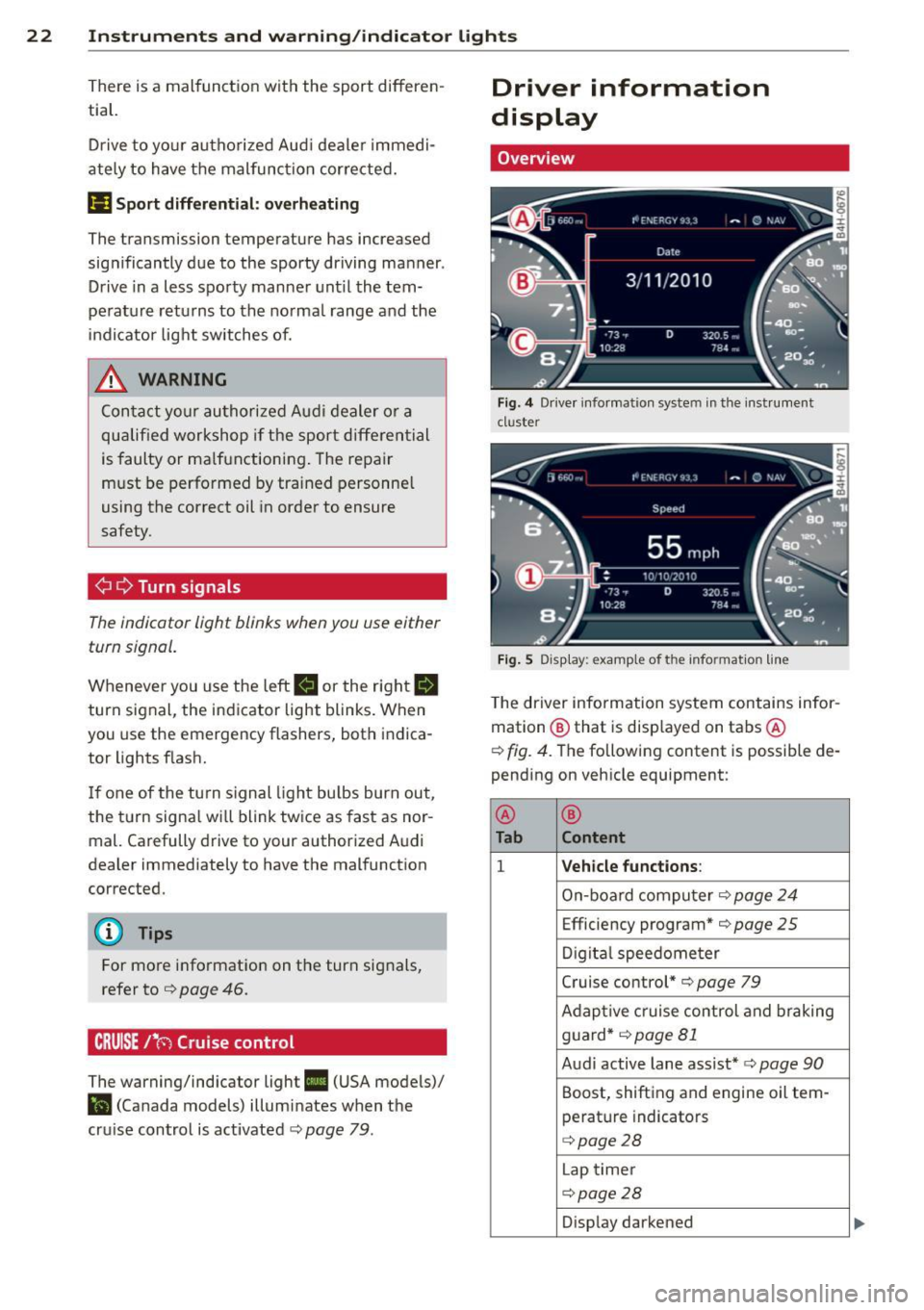
22 Instruments and warning/indicator lights
There is a malfunction with the sport differen
t ial.
Drive to your authorized Aud i dealer immedi
ately to have the malfunction cor rected.
(II Sport differential: overheating
The transmission temperature has increased
significantly due to the sporty driving manner .
Drive in a less sporty manner until the tem
perature returns to the normal range and the
indicator light switches of.
& WARNING
Contact your authorized Audi dealer or a
qualified workshop if the sport differential
is faulty or malfunctioning. The repair
must be performed by trained personnel
using the correct oil in order to ensure
safety.
¢ Q Turn signals
-
The indicator light blinks when you use either
turn signal.
Whenever you use the left. or the rig ht B
turn signal , the indicator light blinks. When
you use the emergency flashers, both indica
tor lights f lash.
I f one of the turn signal light bulbs burn out,
the turn signa l will blink twice as fast as nor
mal. Carefully drive to your authorized Audi
dealer immediately to have the malfunction
corrected.
@ Tips
For more information on the turn signals,
refer to r::!>
page 46.
CRUISE /"(0) Cruise control
The warning/indicator light II (USA models)/
ll (Canada models) illuminates when the
cru ise control is activated
c::> page 79 .
Driver information
display
Overview
Fig. 4 Dr iver informat ion syste m in the instrument
cl uster
Fig. S Di sp lay: exampl e of t he info rmatio n lin e
The driver information system contains infor
mation @ that is displayed on tabs @
c::> fig. 4. The following content is possible de
pending on vehicle equipment:
@
®
Tab Content
1 Vehicle functions :
On-board computer c::> page 24
Efficiency program* c::> page 25
Digital speedometer
Cruise control*
c::> page 79
Adaptive c ruise control and braking
g uard*
c::> page Bl
Audi active lane assist* c::> page 90
Boost, shifting and engine oil tern-
perature indicators
c::> page 28
Lap timer
c::> page 28
Display darkened
Page 25 of 302
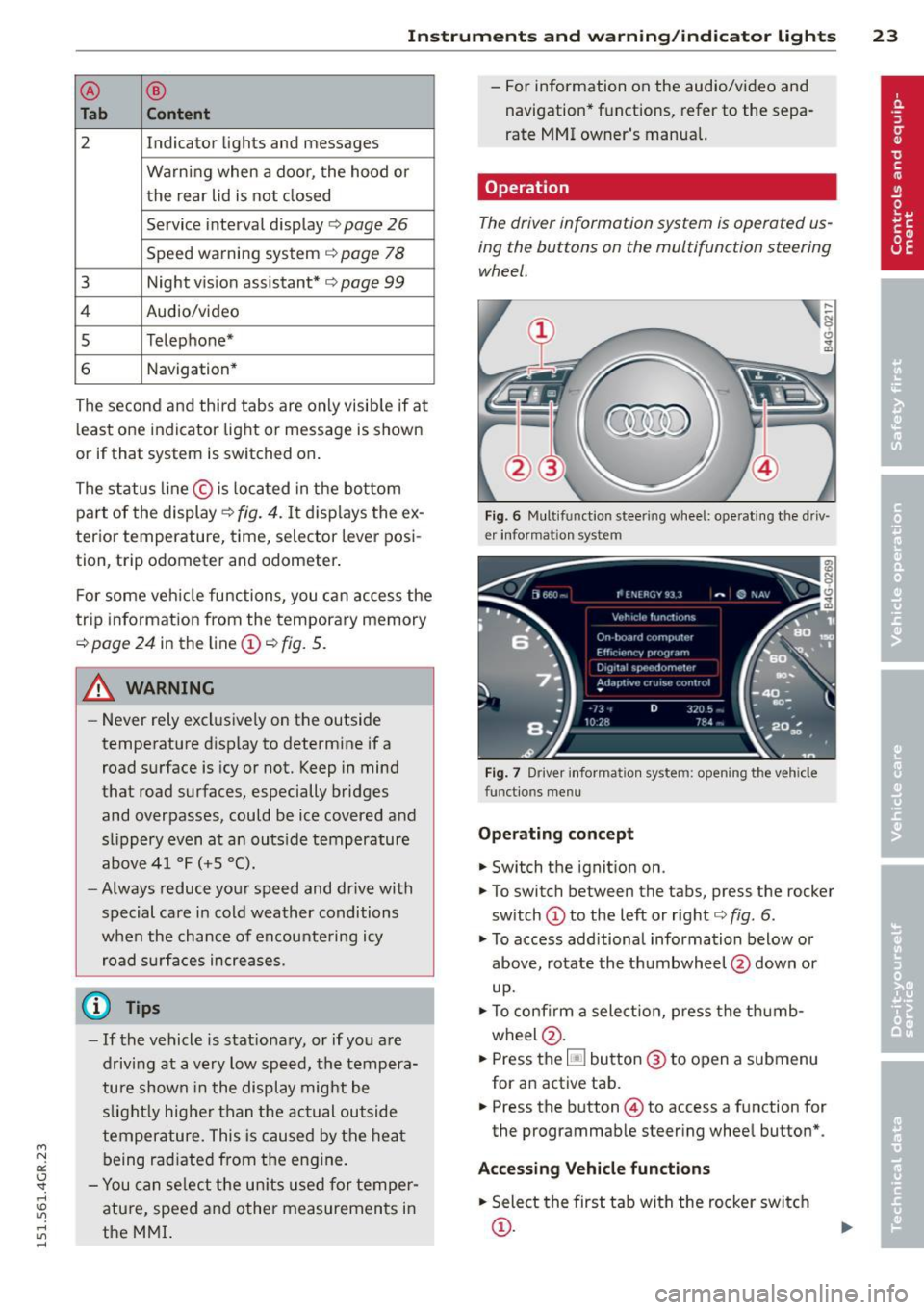
"' N
a:: I.J "". rl I.O
"' rl
"' rl
Instrument s and warning /indicator lights 23
® ®
Tab Content
2 Indicator lights and messages
Warning when a door, the hood or
the rear lid is not closed
Service interval display<=>
page 26
Speed warning system <=> page 78
3 Night vision assistant* <=> page 99
4 Audio/video
5 Telephone*
6 Navigation*
The second and third tabs are only visib le if at
l east one indicator light or message is shown
or if that system is switched on .
The status line © is located in the bottom
part of the display¢
fig. 4. It displays the ex
terior temperature, time, selector lever posi
tion, trip odometer and odometer .
F or some veh icle functions, you can access the
trip information from the temporary memory
<=> page 24 in the line(!)<=> fig. 5.
A WARNING 1= -
- Never rely exclusively on the outside
temperature display to determine if a
road surface is icy or not. Keep in mind
that road surfaces, especially bridges
and overpasses, could be ice covered and
slippery even at an outside temperature above
41 °F (+5 °().
- Always reduce your speed and dr ive with
special care in cold weather conditions
when the chance of encountering icy
road surfaces increases.
@ Tips
-If the vehicle is stationary, or if you are
driving at a very low speed, the tempera
ture shown in the display might be
s light ly higher than the actual outside
temperature. This is caused by the heat
being radiated from the eng ine.
- You can select the units used for temper
ature, speed and other measurements in
the MMI. -
For information on the audio/video and
navigation* functions, refer to the sepa
rate MMI owner's manua l.
Operation
The driver information system is operated us
ing the buttons on the multifunction steering
wheel.
Fig. 6 Multifunction steering wheel: operating the driv
er in formation system
Fig. 7 Driver informat ion system: opening the vehicle
func tions menu
Operating concept
.,. Switch the ignition on.
.,. To switch between the tabs, press the rocker
switch
(D to the left or rig ht <=> fig. 6.
.,. To access additional information below or
above, rotate the t humbwheel @down or
up.
.,. To confirm a selection, press the thumb
wheel @.
.,. Press the~ button @ to open a submenu
for an active tab.
.,. Press the button@) to access a function for
the prog rammab le steering whee l button* .
Accessing Vehicle functions
.,. Select the first tab with the rocker switch
(D.
Page 80 of 302
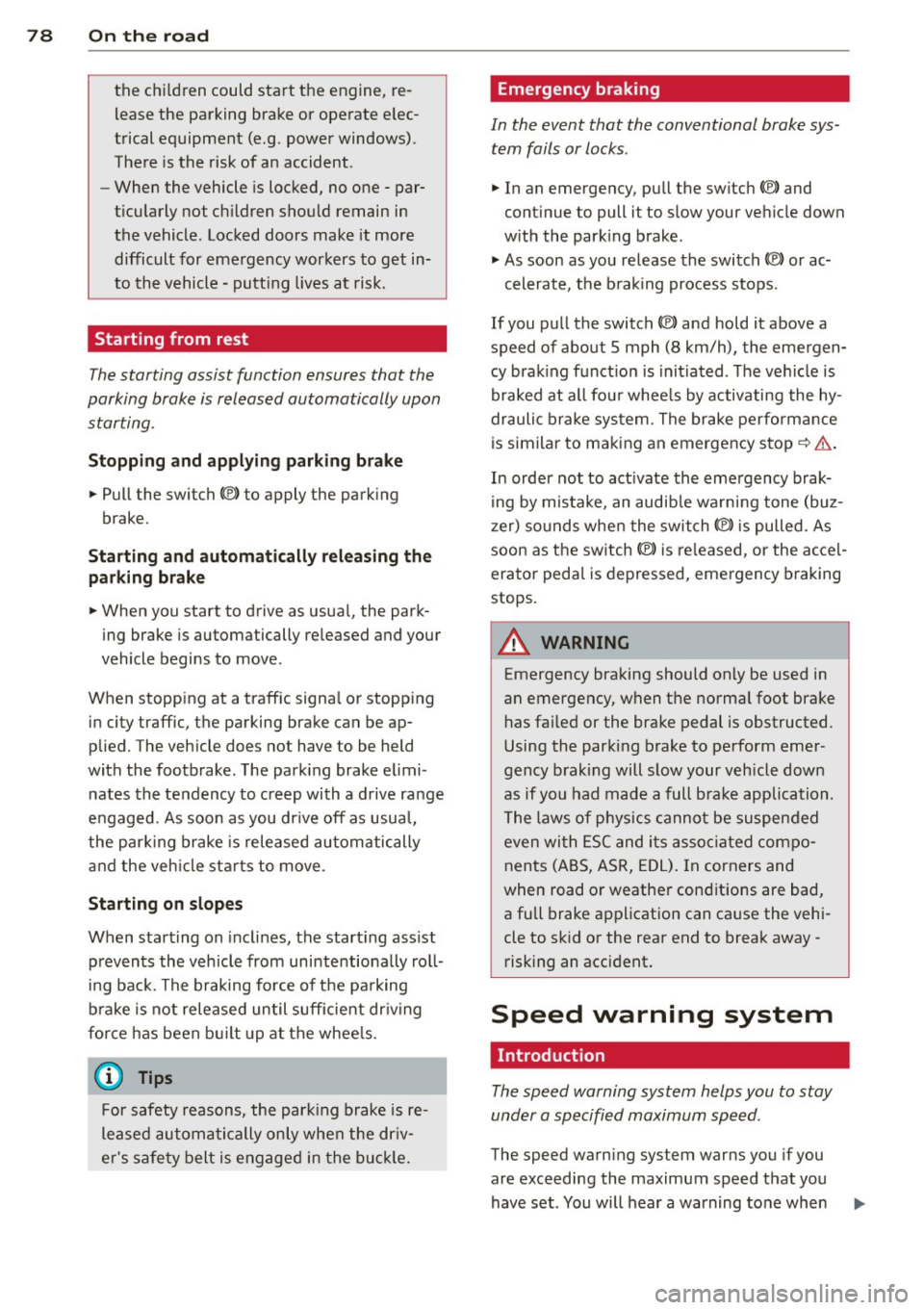
78 On the road
th e chi ldren could start the engine, re
lease the parking brake or operate e lec
trical equipment (e.g. power windows) .
The re is the risk of an accide nt.
- When the vehicle is locked, no one -par
t icu larly not ch ildren should remain in
the vehicle . Locked doors make it more
difficult for emergency wor kers to get in
to the vehicle -putt ing lives a t risk.
Starting from rest
The starting assist function ensures that the
parking brake is released automatically upon
starting .
Stopping and applying parking br ake
• Pull the switch(®) to apply the park ing
brake.
Starting and automat ically releasing the
parking brake
• When you start to d rive as usua l, the park
ing brake is automatically re leased and your
vehicle begins to move .
When stopp ing at a traff ic signa l or stopp ing
i n city t raffic, t he parking brake can be ap
plied. The veh icle does not have to be held
with the footbrake. The park ing brake elimi
nates the tendency to c reep with a d rive ra nge
engaged. As soon as you dr ive off as usua l,
the park ing brake is released automati cally
and the veh icle star ts to move .
Starting on slopes
When starting on incl ines, the start ing ass ist
p revents the veh icle from unintentionally ro ll
i ng ba ck. The braking force of t he pa rking
b rake i s not rele ased until sufficient dr iv ing
for ce has been b uilt up at the whee ls.
@ Tips
For safety reasons, the park ing brake is re
leased autom ati cally only when the dr iv
er 's sa fe ty belt i s engage d in the bu ck le.
Emergency braking
In the event that the conventional brake sys
tem fails or locks .
• In an emergency, pull the switc h(® ) and
con tinue to pull it to slow your ve hicle down
w ith the park ing brake.
• As soon as you release the switch (®) or ac-
c e lerate, t he b ra ki ng process stops.
If you pu ll the switch (®) and hold it above a
speed of about 5 mph (8 km/h), the emergen
cy brak ing f unct ion is init iated . T he ve hicle is
braked at all fou r whee ls by a ctivating the hy
draulic brake sy stem. The br ake pe rfor mance
i s sim ilar to ma king an emergency stop~&. .
In order not to act ivate the eme rgency brak
ing by mis take, an audib le warni ng tone (bu z
z er) sounds whe n the swit ch(®) is pulled . As
soon as t he sw itch (®) is re leased , or the acce l
era tor peda l is depressed, eme rgency braking
stops.
_& WARNING ,_
Emergency braking should only be used in
an emergency, when the norma l foot bra ke
has fa iled or the brake pedal is obstructed.
Using the parki ng brake to perform eme r
gency b raking will s low your veh icle down
as if you had made a full bra ke application .
The law s of physi cs cannot be su spen ded
even wi th ESC and i ts asso ciated com po
nents (ABS, A SR, EDL) . In corners and
when road o r weathe r con ditions are bad,
a full brake application can ca use the vehi
cle to sk id or the rear end to break away -
risking an accident.
Speed warning system
, Introduction
The speed warning system helps you to stay
under a specified ma ximum sp eed .
The speed warn ing system warns you if you
are exceeding the maximum speed that you
have set . You will hear a warning tone when
Page 129 of 302
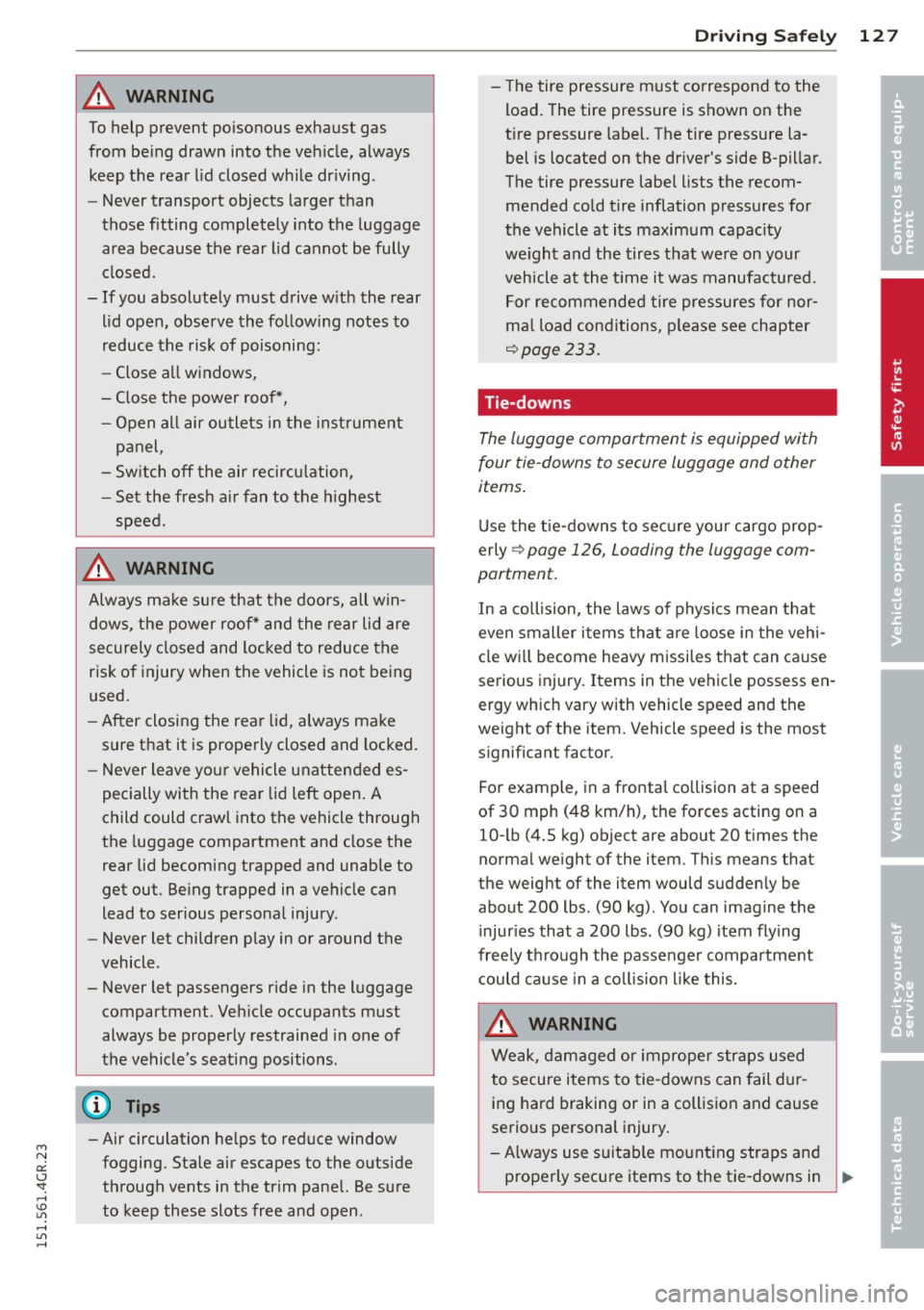
A WARNING ,~
To help prevent poisonous exhaust gas
from being drawn into the vehicle, always
keep the rear lid closed while driving .
- Never transport objects larger than
those fitting completely into the luggage
area because the rear lid cannot be fully
closed.
- If you absolutely must drive with the rear
lid open, observe the following notes to
reduce the risk of poisoning:
- Close all windows,
- Close the power roof*,
- Open all air outlets in the instrument
panel,
- Switch off the air recirculation,
- Set the fresh air fan to the highest
speed.
A WARNING
Always make sure that the doors, all win dows, the power roof* and the rear lid are
securely closed and locked to reduce the
risk of injury when the vehicle is not being
used.
- After closing the rear lid, always make
sure that it is properly closed and locked.
- Never leave your vehicle unattended es
pecially with the rear lid left open. A
child could crawl into the vehicle through
the luggage compartment and close the
rear lid becoming trapped and unable to
get out. Being trapped in a vehicle can
lead to serious personal injury.
- Never let children play in or around the
vehicle .
- Never let passengers ride in the luggage
compartment. Vehicle occupants must
always be properly restrained in one of
the vehicle's seating positions.
Gj) Tips
-Air circulation helps to reduce window fogging. Stale air escapes to the outside
through vents in the trim panel. Be sure
to keep these slots free and open .
-
Driving Safely 127
-The tire pressure must correspond to the
load. The tire pressure is shown on the
tire pressure label. The tire pressure la
bel is located on the driver's side B-pillar.
The tire pressure label lists the recom
mended cold tire inflation pressures for
the vehicle at its maximum capacity
weight and the tires that were on your
vehicle at the time it was manufactured. For recommended tire pressures for nor
mal load conditions, please see chapter
I:!) page 233.
Tie-downs
The luggage compartment is equipped with
four tie-downs to secure luggage and other
items.
Use the tie-downs to secure your cargo prop
erly<>
page 126, Loading the luggage com
partment.
In a collision, the laws of physics mean that
even smaller items that are loose in the vehi
cle will become heavy missiles that can cause
serious injury. Items in the vehicle possess en
ergy which vary with vehicle speed and the
weight of the item. Vehicle speed is the most
significant factor.
For example , in a frontal collision at a speed
of 30 mph (48 km/h), the forces acting on a 10-lb (4.5 kg) object are about 20 times the
normal weight of the item. This means that
the weight of the item would suddenly be about 200 lbs. (90 kg) . You can imagine the
injuries that a 200 lbs . (90 kg) item flying
freely through the passenger compartment
could cause in a collision like this.
A WARNING
Weak, damaged or improper straps used
to secure items to tie-downs can fail dur
ing hard braking or in a collision and cause
serious personal injury.
-Always use suitable mounting straps and properly secure items to the tie-downs in
'
•
•
Page 133 of 302
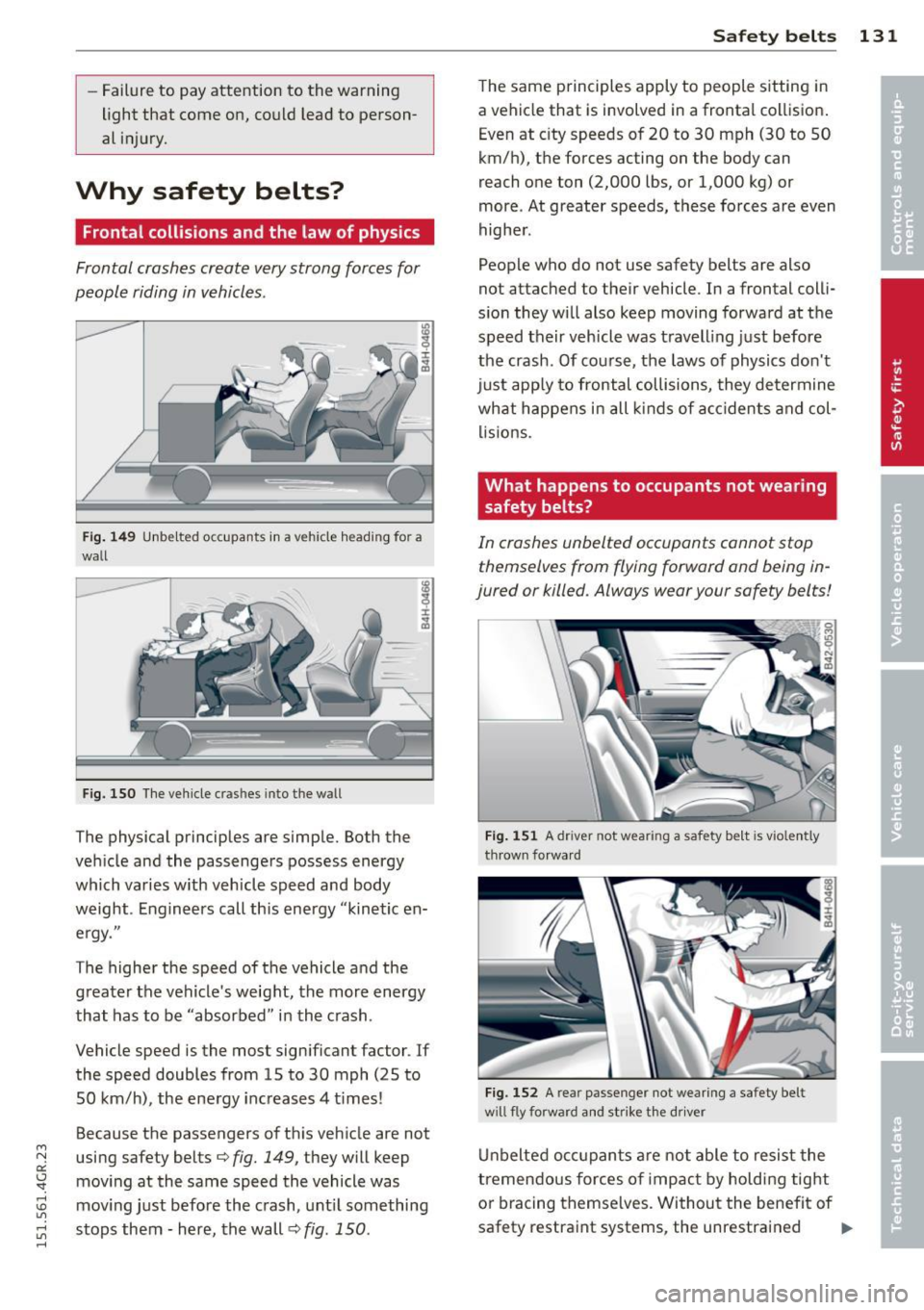
"' N
a:: I.J '
"' rl
-Failure to pay attention to the warning
light that come on, could lead to person
al injury.
Why safety belts?
Frontal collisions and the law of physics
Frontal crashes create very strong forces for
people riding in vehicles .
Fig. 149 Unbelted occupants in a ve hicle heading for a
wall
Fig. 150 The vehicle cras hes into the wall
The physical principles are simple. Both the
vehicle and the passengers possess energy
which varies w ith veh icle speed and body
weight . Engineers call this energy "kinetic en
ergy."
The higher the speed of the vehicle and the
greater the vehicle's weight, the more energy
that has to be "absorbed" in the crash.
Vehicle speed is the most significant factor . If
the speed doubles from 15 to 30 mph (25 to
50 km/h), the energy increases 4 t imes!
Because the passengers of this vehicle are not
using safety belts¢
fig. 149, they will keep
moving at the same speed the vehicle was
mov ing just before the crash, until something
stops them - here, the wall ¢
fig. 150.
Safety belts 131
The same principles apply to people sitting in
a vehicle that is involved in a frontal collision.
Even at city speeds of 20 to 30 mph (30 to 50
km/h), the forces acting on the body can
reach one ton (2,000 lbs, or 1,000 kg) or
more . At greater speeds, these forces are even
higher.
People who do not use safety belts are also
not attached to their vehicle . In a frontal colli
sion they will also keep moving forward at the
speed their vehicle was travelling just before
the crash . Of course, the laws of physics don't
just app ly to frontal collisions, they determine
what happens in all kinds of accidents and col
lisions.
What happens to occupants not wearing safety belts?
In crashes unbelted occupants cannot stop
themselves from flying forward and being in
jured or killed. Always wear your safety belts!
Fig. 151 A driver not wea ring a safety be lt is vio lently
th rown forward
Fig. 152 A rear passenger not wearing a safety belt
w ill fly forward and strike the driver
Unbelted occupants are not able to resist the
tremendous forces of impact by holding tight
or bracing themselves. Without the benefit of
safety restraint systems, the unrestrained .,..